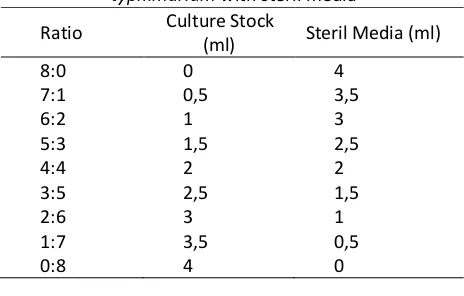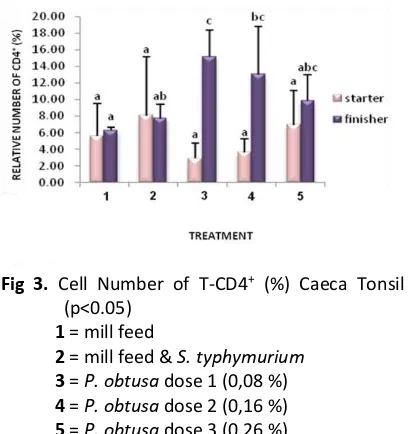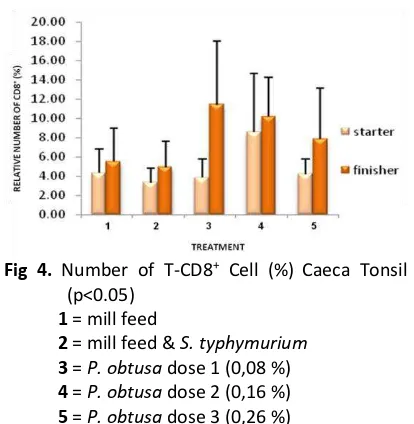20
Effectivity of Polyscias obtusa Simplicia as Immunomodulator on
CaecaTonsil of Broiler Post Infection of Salmonella typhimurium
Mutya Farsely, Muhammad Sasmito Djati
*, Muhaimin Rifa’i
Laboratory of Animal Physiology, Department of Biology, Faculty of Mathematics and Natural Sciences Brawijaya University, Malang
ABSTRACT
Antibiotics usually used to protect the animals from pathogens, but antibiotics have residues which have negative side efect. Antibiotics can substituted with Polyscias obtusa simplicia because this plant contains a chemical compound called Flavonoid which roles in immune system as immunomodulator. This study aimed to determine the mobilization and development of CD4+, CD8+ and B220+ T-Cells lymphocytes from thymus of broiler that have been given additional
feed Polyscias obtusa after infected by Salmonella typhimurium and determine the optimum dose of the addition of
simplicia’s Polyscias obtusa which can influence the mobilization of T-Cells lymphocyte in Thymus. The procedure are confirmation of the Salmonella typhimurium isolates, prepare the simplicia’s Polyscias obtusa and Salmonella typhimurium bacterial culture, orally infections in 500 µl, prepare supplemented feeds by three doses (i.e. dose 1 (0.08%), dose 2 (0.16%) and dose 3 (0.26%)), thymus and T-Cells lymphocytes isolation and Flowcytometry analysis. The results showed that feeding with antibiotical feed + Salmonella infection and natural feed with additional Polyscias obtusa simplicia’s dose 2 (0.16%) have increased the relative number of CD4+, CD8+ and B220+. T-Cells lymphocytes of
thymus with different time feeding period have significant differences for relative number of CD8+. This result gave
proof that Polyscias obtusa simplicia have the ability and influence to increase the body's immune system.
Keywords : Broiler, Polyscias obtusa, Salmonella typhimurium, T-Cells lymphocyte, Thymus
INTRODUCTION1
Recently, drugs usage for the prevention and treatment of animal diseases is becoming increasingly important. This is due to the increasing demand of livestock products, such as meat, eggs and milk. Presence of antibiotic residues in livestock products and the development of resistant microbes consumed either by animal or human caused by less attention at sub-therapeutic levels to the antibiotics usage [1]. Therefore, to maintain production efficiency on safe consumption of broiler farms, it is necessary to arrange the use of alternative feed supplement that can boost the immune system of the chickens.
Various kinds of medicinal herbs widely used for humans and animals as a substitute for antibiotics. One such plant is Kedondong Laut (Polyscias obtusa) that contain flavonoids and new polysciosida called polysciosida AH on its leaves and root [2]. Flavonoid compound known as agent of immunomodulator, antiviral and
*
Correspondence Address Muhammad SasmitoDjati Email : [email protected]
Address : Department of Biology, Faculty of Mathematics and Natural Sciences, Brawijya University, Jl. Veteran, Malang 65154
antioxidant [3]. Flavonoid also estimated to promote lymphocytes proliferation, increasing the number of T cell and improving IL-2 activities [4,5]. Francis et al. [3] mentioned that saponin is an important nutrition compound for human and animals. Saponin also known acted on membrane permeability, as immunostimulant, agent of anticarsinogen and hypocholesterolaemic.
Based on previous research, leaves extract of Polyscias obtusa can mobilize haematopoetic stem cells (CD34+, T CD4+, CD8+, CD25+ and
CD62L) in S. thypii infected mice [6]. Empirical fact also found in Sleman, Yogyakarta, where this herb widely used as an animal feed and known that animals that consume these plants able to avoid the attack of avian flu outbreaks.
Based on these descriptions, scientific experiment needs to be done to determine the modulation and development of chicks cellular immunity after additional food feeding of leaves simplicia of Polyscias obtusa which has been infected before with Salmonela typhimurium, by observing the alteration cell number of CD4+ and
CD8+ cell in caeca tonsil organ.
METHODS
J.Exp. Life Sci. Vol. 3 No. 1, 2013 21 Biology, Facultu of Mathematics and Natural
Sciences, and Field Laboratory of Sumber Sekar-DAU Faculty of Animal Husbandry, Brawijaya University, Malang.
Material and Equipments
Equipment of this research are cages, lights, place chicken feed containers, chaff, reaction tubes, petri dish, oose, Bunsen, vollume pipettes, suction ball, Erlenmeyer, micropipettes, blue tip, wire, syringe, propylene tubes, ice box, sentrifuge, and flowcytometer. The used materials are media of XLD, KIA, LIA, NB, NA,
Subcultured colonies inoculated in XLD (Xylose Lysine Deoxycholate) media and then incubated for 24 hours at temperature of 370C.
Positive result on XLD media showed by black colored colonies.
Catalase Test
Subcultured colonies smeared on glass object which treacled with one drop of hydrogen peroxide (H2O2) 3%. Positive result showed when
there were gas bubbles. conducted morphology observation. The result showed that the bacteria is gram negative by its red colored cells.
KIA LIA Test
Positive colonies taken with graft and putted on KIA and LIA slant media then lines drawn to form lineage on slant. And then incubated in 370C
for 24-48 hours. Black colored colonies on media indicated positive test results.
Standard Curve
Isolates suspension cultured in Nutrien Broth media in different ratio between the
concentration (dillution) explained in Table 1. Each suspension absorbance was assessed with spectrophotometer on 600 nm wave length and cell number was counted with haemocytometer.
Table 1. Comparison of bacteria of Salmonella typhimurium with steril media
Ratio Culture Stock Sampling were done in every 1 hours by taking 4 ml and the addition of 500 µl formalin. Subsequently, absorbance were calculated with a spectrophotometer at a wavelength of 600 nm and smoothed with a dry blender, then weighed to the artificial feed additives according to treatment, i.e. dose of 0,08%, 0,16% and dosis 0,26% of the total feed. Feed manufactured in order of feed percentage composition, from lowest to the highest dose.
Oral Infection of Salmonella typhimurium Bakteri Salmonella typhimurium dalam Nutrient Broth disentrifuse dengan kecepatan 10.000 rpm selama 10 menit suhu 250 C.
Obtained pellet resuspended in physiological saline solution 0.9% NaCl, then taken 500 mL and fed orally (through the mouth) to infected chickens.
Isolation Lymphocytes Cell
J.Exp. Life Sci. Vol. 3 No. 1, 2013 22 Obtained results putted in propylene tubes and
added 12 ml PBS, and centrifuged at 2500 rpm, temperature of 40C, for 5 minutes. Supernatant
were rwmoved and remained pellet resuspended with 1 ml PBS. Pipetting applied then to get homogenates. 50 µl homogenates moved into another new microtube and added 500 µl PBS. Then centrifuged at 2500 rpm, temperature 40C
for 5 minutes. Supernatant was discarded and pellet containing lymphocytes was obtained.
Flowcytometry Analysis
Isolated cells from caeca tonsil incubated in 50µL Rat anti-CD4+ PE (R-Phycoerythrin) and Rat
anti-CD8+ FITC (Fluoresence Isothiocyanat)
antibodies for 15 minutes. Sample then added with 1 ml PBS moved into flowcytometer cuvette. Furthermore, flowcytometer calculated the relative number of total cells and the number of cells detected by antibody labeling. Obtained result processed further with BD cellquest Pro TM program.
Statistic Analysis
Data were analyed with factorial complete randomized design with SPSS 16.0 program. Subsequently, data were analyzed using multiple analysis of variance. If the obtained results are significant then processed further with Tukey test.
RESULT AND DISCUSSION
Comparison of Relative Cell Number of CD4+ on
Caeca Tonsil Organ of Starter and Finisher Group Results in Fig. 3 showed that there is no significant difference between treatment groups in all starter group. The results were not significant presumably caused by the time treatment is still in the adaptation stage, so that the antibody response in chicks confined to a particular antigen epitopes. Immunologic respond in young animals still at the lowest levels of immunological [7].
S. typhimurium that infect 1-2 weeks aged chicks only caused low antibody response. This condition may caused by the nature of hiporesponsive cells in the immune system which has not maturely functioned yet, or dissemination of lymphoid tissue is still too early and antibody formation was rudimentary [8].
While in finisher group, the relative number of CD4+ significantly difference in the treatment
group 0.08 % dose compared with the treatment of mill feed. However, changes in the relative number of CD4+ occurred in the treatment group
P. obtusa dose of 0.08 %, 0.16 %, and 0.26 %, which shows the increase of relative number of CD4+ in group finisher than starter, i.e. 12,22 %
enhancement in treatment group of 0,08% dose P. obtusa. Thus it is presumably that the addition of P. Obtusa simplicia in the artificial feed increased the relative number of CD4+ caeca
tonsil of Broiler with optimum doses of 0.08 %. The real difference between the relative number of CD4+ starter and finisher group
allegedly because flavonoids as immunomodulatory properties that can be turned into imunosupressan to the average index of phagocytic macrophages, when given in large doses and for long periods of time.
Fig 3. Cell Number of T-CD4+ (%) Caeca Tonsil
Caeca Tonsil Organ of Starter and Finisher Group The results in Fig. 4 shows that there is significantly no difference in the relative number of CD8+ in all treatment groups in both starter
and finisher group (p> 0.05). However, based on the treatment period, the relative number of CD8+ in the P. obtusa treatment finisher group
increased more than starter group, with the highest increase of 7.58 %, at 0.08 % dose administration of P. obtusa.
J.Exp. Life Sci. Vol. 3 No. 1, 2013 23 based on the pattern of cytokine secretion, the
response patterns of Th1 and Th2 [9,10].
Fig 4. Number of T-CD8+ Cell (%) Caeca Tonsil
Lymphocytes subset Th1 through its production, i.e. interferon- (IFN-), 2 and IL-12. IFN - involved in the creation and presentation of antigenic peptides on the cell surface, because IFN- has the ability as a factor in macrophage activation. Meanwhile, IL-12 is the main and the most important cytokine in induction to Th1 subset, either in vitro or in vivo [11]. Thus, T cell differentiation into T-CD4+ cells
increased because the role of these cytokines after administration of P.obtusa simplicia with different doses.
Flavonoids contained in P. obtusa indirectly affect the activity of T-CD8+ cells, so that the
relative number of CD8+ was not significantly
different among all treatment groups. Mechanism of flavonoid and alkaloid of P. obtusa as immunomodulator, which increased the activity of IL-2, also indirectly increase the activity of IFN-. IFN-, in addition to having a unique ability to regulate the expression of MHC II molecules, so as to improve the response of T-CD4+ cells lymphocytes, also increased the
expression of MHC molecules I. Consequently, IFN- helps to improve or optimize the cytolytic activity of cytotoxic T-lymphocyte (CD8+) which
only recognize antigen or target cell when antigen was presented with MHC molecules I. In other words, for the full differentiation, T-CD8+
cells need cytokines that produced by T-CD4+
cells or co-stimulator that expressed on infected cell [12,13,14,15,16,17].
CONCLUSION
There are significant differences between treatment groups Polyscias obtusa dose of 0.08% with mill feed in terms of the relative number of CD4+. The treatment duration lead to significant
difference results on the relative number of CD4+
and CD8+ cells. The best treatment in increasing Vietnamese Culture, Business, and Telecommunication. Accessed October 2nd
2012.
[2] Huan, V.D., Sato, Y., Nguyen, T.N. & Hoang, M.C. 1998. Oleanane Saponins From Polyscias Fruticosa. Science direct.
[3] Francis, G., Zohar K., Harinder, P.S.M. & Klaus, B. 2002. The biological action of saponins in animal sistems. British Journal of Nutrition. 88, 587–605.
[4] Abbas, A.K., Litchman, A.H. & Pober JS. 1994. Cellular Immunology in: Cellular and molecular immunology 2nd Ed. Philadelphia: WB. Saunders Company.
[5] Rifa'i M., Kawamoto Y., Nakashima I., Suzuki H. 2004. Essential roles of CD8+CD122+
regulatory T cells in the maintenance of T cell homeostasis. The Journal of experimental medicine, 200 (9): 1123-1134. [6] Wulan, S. 2012. Haematopoietic Mobilization
of Stem Cells by Leaves of Polyscias Obtusa Specifically Detect Salmonella Enteritidis. Int. J. Food Microbiol. 21: 47– 49.
J.Exp. Life Sci. Vol. 3 No. 1, 2013 24 active regulatory cells. International
immunology, 20 (7): 937-947.
[11]Trincheri, G. 1995. Interleukin-12: A proinflammatory cytokine with immunoregulatory function that bridge innate resistance and antigen-specific adaptive immunity. Immunol. 13: 251-276. [12]Samuel, C.E. 2001. Antiviral actions of
interferon. Clinical Microbiol. Rev. 14(4): 778-809.
[13]Lee Y.H., Ishida Y., Rifa’i M., Shi Z., Isobe K., Suzuki H. 2008. Essential role of CD8+CD122+
regulatory T cells in the recovery from experimental autoimmune encephalomye-litis. The Journal of Immunology, 180 (2): 825-832.
[14]Shi Z., Okuno Y., Rifa'i M., Endharti AT., Akane K., Isobe K., Suzuki H. 2009. Human CD8+CXCR3+ T cells have the same function
as murine CD8+CD122+ Treg.
European journal of immunology, 39(8): 2106-2119.
[15]Shi Z., Rifa’i M., Lee Y.H., Shiku H., Isobe K., Suzuki H. 2008. Importance of CD80/CD86– CD28 interactions in the recognition of target cells by CD8+CD122+ regulatory T cells.
Immunology, 124 (1): 121-128.
[16]Endharti, A.T., M. Rifa'I, Z. Shi, Y. Fukuoka, Nakahara, Y. Kawamoto, K. Takeda, K. Isobe, H. Suzuki. 2005. Cutting edge: CD8+CD122+ regulatory T cells produce IL-10 to suppress IFN-gamma production and proliferation of CD8+ T cells. Journal of immunology, 175 (11): 7093-7097.
[17]Lee Y.H., Rifa'i M. 2011. CD4+CD25+ FOXP3+


